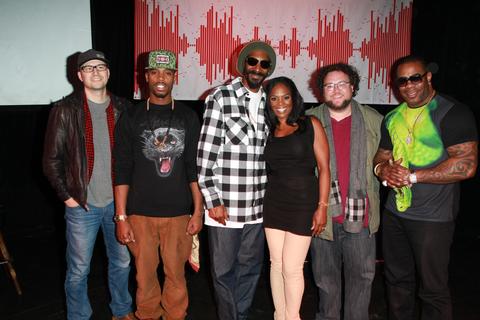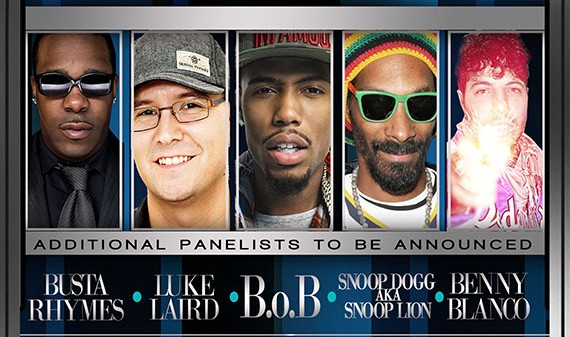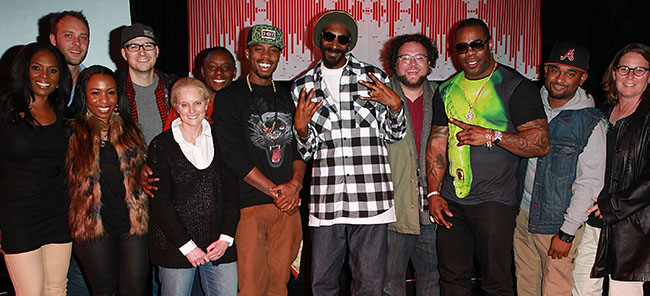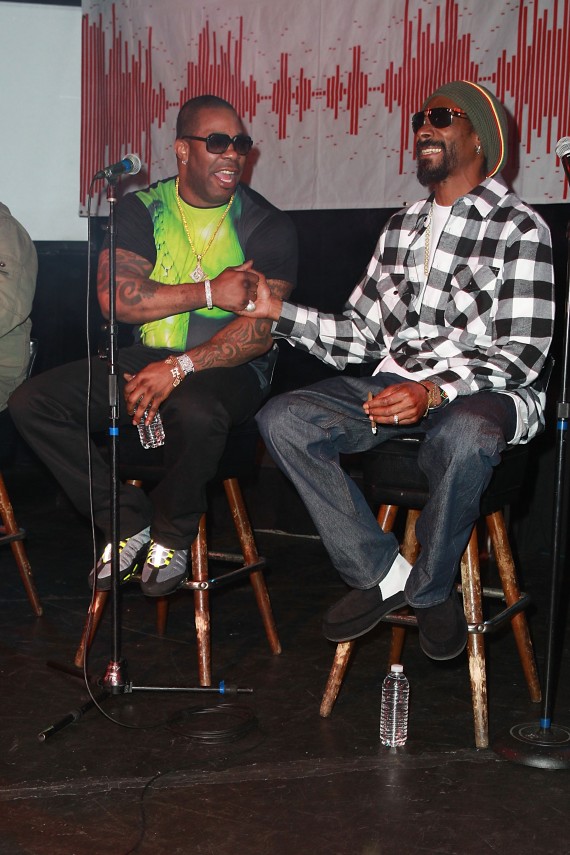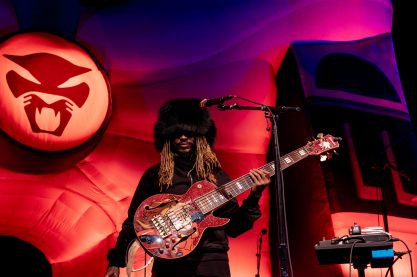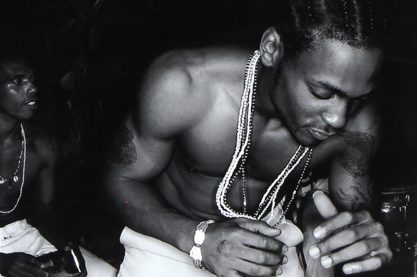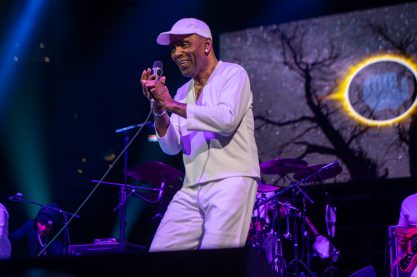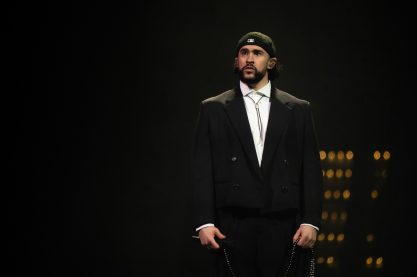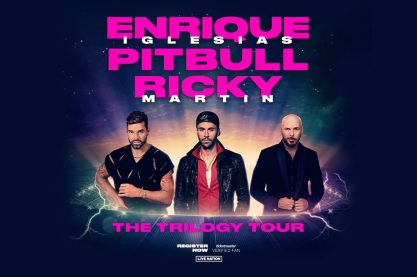Music
Event: BMI's How I Wrote That Song, Los Angeles, CA
EVENT: BMI'S How I Wrote That Song, Los Angeles, CA. Roxy Theater, West Hollywood, CA. February 9, 2013
There is something about songcraft. The art of songwriting is a fascinating topic. Is it more formulaic, like Diane Warren writing out of her office? Or is it more organic? Perhaps, a convergent of ideas that is somehow through magic and alchemy, put together through space and time called music. While iconic names, Snoop Lion and Busta Rhymes, grabbed the spotlight; the more interesting voices at the BMI Music's How I Wrote That Song session, were that of the songwriters, Luke Laird and Evan Bogart, met with the members of the media before taken part on the panel with Snoop Lion, Busta Rhymes, and B.O.B.
Regarding the process, Evan Bogart said, “You can’t really bottle the song writing process, it is about hearing songs and the melody for it.” As far as writing hit songs, Evan Bogart has his take on it. “I never want to jinx something,” he said, “so I never say it is a smash or a hit.” Evan said a good song is “a perfect storm” of music and melody and “a little bit of magic.” He also said that “Tainted Love” by Soft Cell, the song he sampled for Rhianna’s “S.O.S.” inspired him to be a songwriter. “I was doing other stuff until I wrote that hit song then I thought ‘I can do this.’”
I talked at length with country and pop songwriter Luke Laird about his background and the songwriting process. Luke reminded me of people I grew up with in small town Illinois, just more creative and not racist. The Conneault Lake, Pennsylvania native informed me that growing up, he loved both country music and hip-hop music. “Growing up and being in high school in the 90s, I listened to Garth Brooks and whatever was on the radio, which led to older stuff like Merle Haggard and Johnny Cash,” he said, “I loved the storytelling aspect.” “I also loved the Chronic album and Snoop Dogg, and a lot of country producers my age have incorporate that ‘bounce’ into country music,” he continued. I asked Luke about the songwriting process, as I am always curious to hear how real songwriters approach their craft. “It varies,” he said, “I will either sit down with a guitar or make a beat first on beat-logic.” “I have a notebook full of titles and lyrics on my phone, or sometimes we (songwriters) will just sit around and talk about our lives." He explained to me that he sometimes craft songs specifically for an artist, but when working by himself or with another songwriter, he will usually just try to write the best song he can. “There’s no formula, except for the chorus, it is just how you feel,” he concluded. Luke informed me that he is especially excited about his work with new country star, Hunter Hayes, and also a song on Ne-Yo’s new record.
Forty five minutes after the scheduled time, the panel on “How I Wrote That Song,” finally started with Snoop Dogg lighting a spliff, which he would later pass to B.O.B, who accepted. The panelists, propped on chairs, sitting on the stage were from left to right, Luke Laird, B.O.B., Evan Bogart, Busta Rhymes, and Snoop Lion. The hostess would introduce a song written by one of the members of the panel and ask him for the songwriting process of that particular song, which was blared through the Roxy Theater and showed on the video screen for the audience.
The session started with Carrie Underwood’s “Last Name,” which was co-written by Luke Laird, who commented that he initially could not think that Underwood would do a song about meeting a guy and not knowing his last name. Laird demonstrated his song writing process by strumming his guitar melodically and beat boxing with his mouth and tapping his guitar for percussive effect. B.O.B. explained his hit, “Airplanes,” as foreshadowing to what his life is now. “You know that quote ‘you can’t mastermind everything but you can be prepared,’” he told the audience. He mentioned that his hit songs have mostly come “effortlessly.”
The next song was Beyonce’s “Halo,” which Evan Bogart co-wrote with Ryan Tedder. Bogart stated that he was a big fan of Ray LaMontagne, and that “Halo” was influenced by LaMontagne’s “Shelter.” He also mentioned that as a songwriter, he was picturing what Beyonce would sing to Jay-Z. Busta Rhymes explained “Put Your Hands Where My Eyes Could See” as his reinvention. He told the audience about Q-Tip and Diddy telling him to stop screaming and use his own normal voice. Busta listened and was trying to sound like Diddy on the intro and ad-libs. He also told the audience about the Bomb Squad influences of his music and about working with Hype Williams on the videos. “The great thing about working with Hype is that he can execute any idea I come up with,” he said.
Snoop Lion was particularly engaging while discussing “Nuthin’ But a G Thang.” “I was living on Tenth and Lime in the LBC with my cousin DeAndre,” he said. “I actually wrote that song while I was in jail,” he continued. He told the audience that he sent it to Dr. Dre, and when Dre heard the vocal, “he (Dr.Dre) had to record it.” “Hillbilly Bone” by Blake Shelton was actually a rap song at first, explained Luke Laird, and he demonstrated by rapping the lyrics, then slowing it down into a sung country song. Busta Rhymes explained “Woo Haa” as “an homage to the old school.” He told the audience that the call and response and rhyme scheme was influenced by Jamaican sound clashes he grew up listening to in New York.
Busta’s “Woo Haa!! Got Your All in Check” call and response and the rhyme scheme were influenced by the Jamaican sound clashes. Snoop discussed working with Pharrell Williams of the Neptunes on “Drop It Like It’s Hot.” He described his partnership with Pharrell as a “brotherhood.” “Pharrell would make these noises and play the melody with his tongue,” Snoop Lion said, and then told the audience that he took the melody, and then added the lyrics to the track.
When discussing “Nothin’ on You,” B.O.B. was philosophical about the subject of hit records. “You never know what is going to be a hit,” he said, “it is up to the consumer.” He explained to the audience that while he knows if a song is “good” or “bad,” the idea of a hit is entirely up to the masses. “When it comes to songwriting, you have to put your personality on a record,” he continued, “it is not about the lyrics, as the lyrics can take the soul out of it.” “I just try to just be in the moment,” he said. He described putting his personality on a record as similar to fashion, and trying on different outfits.
Evan Bogart described Rhianna’s “S.O.S” as “magic.” He informed the audience that he was an aspiring rapper. “’88 to ’95 hip-hop was my biggest influence,” he said, “I thought I was part of the Native Tongues.” “I told ‘Tip, Ali, and Phife, and they all laughed at me,” he shared. “J.R. Rotem said to me, ‘Evan, you rap, you write funny songs, why don’t you try songwriting,” he continued. He told the audience that he wrote “S.O.S” like a rap song. “Back then, I knew nothing about melody,” he said, “and now I realize less is more, “S.O.S” was too wordy.” He explained how he thought it was cool to have all the 80s references in the song as an homage to the 1980s, but that “a pop audience is not going to care about that.”
Busta Rhymes reminisced about the Leaders of the New School-A Tribe Called Quest collaboration, “Scenario.” He informed the audience that there were many versions of the record. “There was a version with De La on it, there was a version with Black Sheep on it,” he said, “but ‘Tip always wanted to make it a Tribe-Leaders of the New School record.” He told the audience that he got stuck at the line, “as I come back,” and the people thought he did the rhyme sequence and pauses on purpose. Snoop described “Beautiful,” as Pharrell giving him a way to “tap into his R&B side, and tapping into his grown and sexy.” He said that even though his lyrics from his earlier works may have been harsh to women, because he came up from the pimp perspective, he did not hold any animosity to women, and “Beautiful” was a way for him to show his appreciation for women.
Busta Rhymes discussed branding in “Pass the Courvoisier,” and how if people can see themselves in the song with the product, they are more likely to buy the product, and thus, corporate America is brought in and bought in. The last song discussed was Snoop Lion-Wiz Khalifa collaboration, “Young, Wild and Free.” Snoop said, “I have never won a Grammy, but if I win for this shit, advising kids to smoke weed and be young, wild, and free, then something is wrong.” He informed the audience that Bruno Mars sent him the song, and that he became close friends with Wiz after working on the track. That was the last song discussed. The panel dispersed after a few questions for Luke Laird, Evan Bogart, and Snoop Lion. The crowd and members of the media seemed happy at the knowledge they gained, although, all I learned is that songwriting is an organic process that really has no formula -- but I already knew that.
